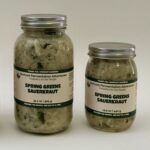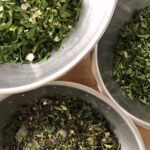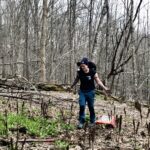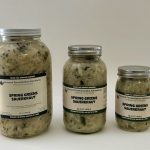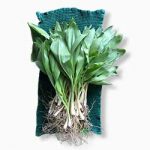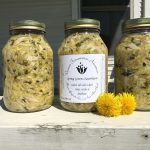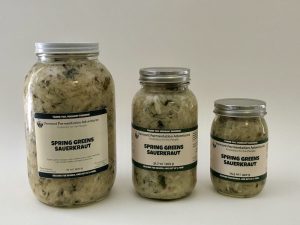 Spring Greens Sauerkraut emerged as a celebration of the warming weather and friendship. If you have a chance to visit us at farmers’ markets, you may have met Elisabeth, my amazing production manager, “life facilitator,” and long time friend. Ever the multitasker, she’s pictured in her ramp stash with her cat on catching a ride on her shoulders. We met as homeschooling parents long ago and have been fast friends ever since. Elisabeth gave me my first lesson in ramps, or Vermont’s famous wild leeks/onions/garlic, generously sharing her ramps stash with me and teaching me how to responsibly gather them. See the More Kraut Info about safely and sustainably gathering wild edibles if you are interested.
Spring Greens Sauerkraut emerged as a celebration of the warming weather and friendship. If you have a chance to visit us at farmers’ markets, you may have met Elisabeth, my amazing production manager, “life facilitator,” and long time friend. Ever the multitasker, she’s pictured in her ramp stash with her cat on catching a ride on her shoulders. We met as homeschooling parents long ago and have been fast friends ever since. Elisabeth gave me my first lesson in ramps, or Vermont’s famous wild leeks/onions/garlic, generously sharing her ramps stash with me and teaching me how to responsibly gather them. See the More Kraut Info about safely and sustainably gathering wild edibles if you are interested.
Then, one day Elisabeth mentioned she was out hunting for nettles…. Ramps, nettles, dandelions are all in abundance in the early Vermont spring, so whoosh! Test batches, ingredient adjustments, and printed labels later—boom! Spring Greens Sauerkraut and the start of our Seasonal Greens Series. Enjoy its mild, nourishing, wild Vermont flavors while you can.
Product Details
Nutrition Facts
Servings in a pint jar: 15,
Servings in a quart jar: 31,
Servings in a half-gallon jar: 67,
Serving Size: 2 Tbsp (29g),
Amount Per Serving: Calories 10, Total Fat 0g (0% DV), Saturated Fat 0g (0% DV), Trans Fat 0g, Cholesterol 0mg (0% DV), Sodium 180mg (8% DV), Total Carbohydrates 2g (1% DV), Protein 0g.
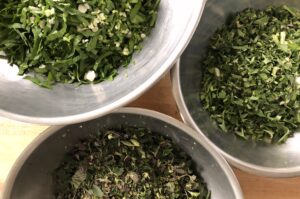
As as business that occasionally uses Vermont’s amazing wild edibles, I feel it is important to mention how we, and by extension, how you could, sustainably gather the wild foods we put in our sauerkrauts.
Everything has a limit, right? We see more and more how our human wishes, which some might call needs, are depleting the planet of its abundant resources, most of which we humans had nothing to do with their creation, propagation, and beauty. It is in these resources’ utility to us that we start mucking about with their existence, and sometimes through need, and yes probably greed, we wreck the very item we cherished. I pray we can reel ourselves in before we wreck this planet that we cherish.
So, little things, yes? We can’t dictate the choices of our beloved (or not so beloved) political representatives, but we can adjust our choices toward living more in harmony with the balance of humanity and the natural world. It all adds up. From the small things like remembering our reusable bags when we shop to the bigger things of what we drive or how we heat our homes, our choices synthesize with everyone else’s and we get to where we are. Here’s hoping that my own choices will lean more toward regeneration and less toward depletion in the time I have left.
Alas, gathering ramps! They are a hardy bunch and can flourish in the right environment, so hooray for you if you have one of these marvelous stashes in your neighborhood. If you are an experienced ramp gatherer, I’d say the least impactful method of gathering them is to simply clip them at ground level, enjoying a bit of the stalk and wonderful leaves. That’s what we do in our work, and leaving the bulb to multiply and grow for another season still gives us plenty of that wonderful wild onion flavor in our ferments.
If you are new to gathering ramps, I have two ideas: 1) gather ramps a few times with an experienced friend. There are plenty of look alikes that grow during or just following ramp season, and some of these are toxic. Every spring, folks get sick in Vermont from eating what they thought were ramps, so please don’t join this list of unfortunate people. No matter how wonderful you think they are, they are not worth getting seriously ill—or worse—over. 2) Once you have a strong sense of what they look like—leaf number, shape and color, habitat, various changes during growth, plant smell, stalk colors, root shape, growth patterns, etc— persist in sustainably digging them for a season or two. In this way, you’ll see the whole plant you are planning to eat, and the root and bulb are an important part of its identification. But how do you sustainably dig up a ramp, which effectively kills the plant? You do it gently. Ramps at their best will carpet their woodland habitat, and you can judiciously dig them without interfering with their regeneration. Dig a clump, maybe 4-8 bulbs, in one location, and then wander to another spot and dig another clump. Imagine yourself to be “thinning the ramps” as we’d thin our beets or carrots when they emerge in the early summer. Think of your sustainably ramp gathering outing as one part digging to one part wandering. Or better yet, give yourself some time and wander much more than you dig. It is a wonderful way to spend a spring afternoon, for sure.
After one or two seasons of safely and sustainably digging your ramps, leave your shovel at home and head out with some scissors. Clip the ramps off just above the ground and revel in how smart you are. By this point in your ramp loving career, you’ll know that gathering ramps takes at least as long as cleaning ramps that have been dug. The ones we cut and carry bring us as much pleasure and deliciousness with a fraction of the prep time once we’re home.

